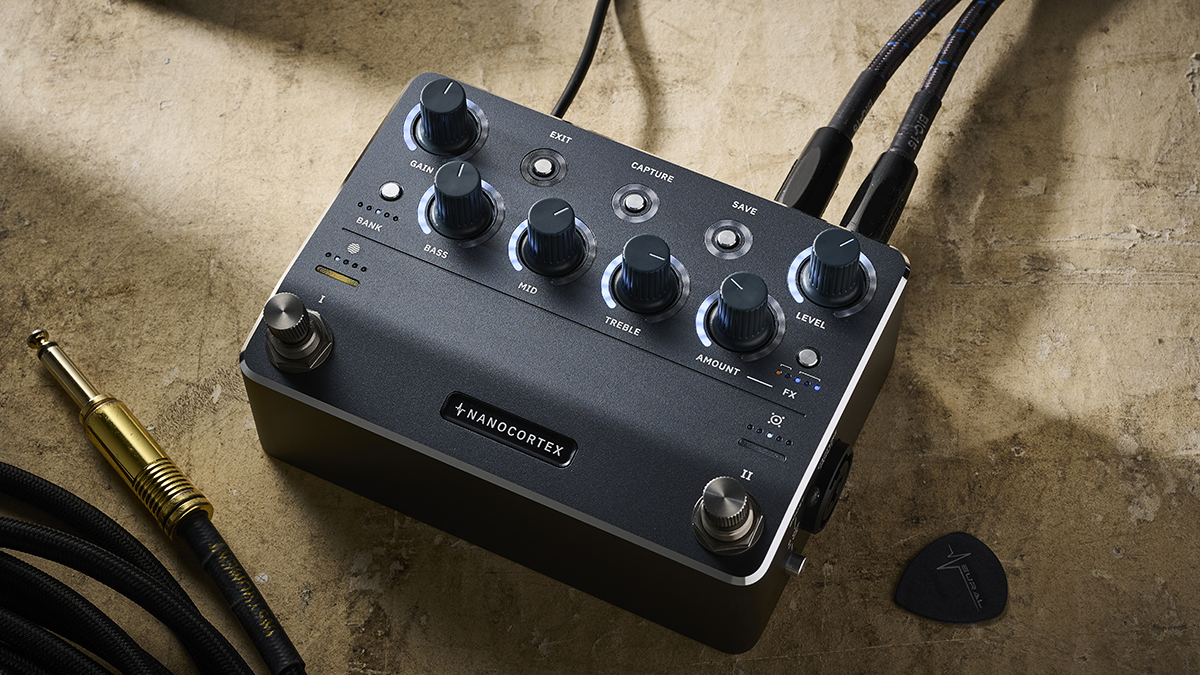Best 8-string guitars 2025: embrace the low-end with our djent-friendly electrics for all budgets
Extend your low end beyond your wildest dreams with our selection of the best 8-string electric guitars
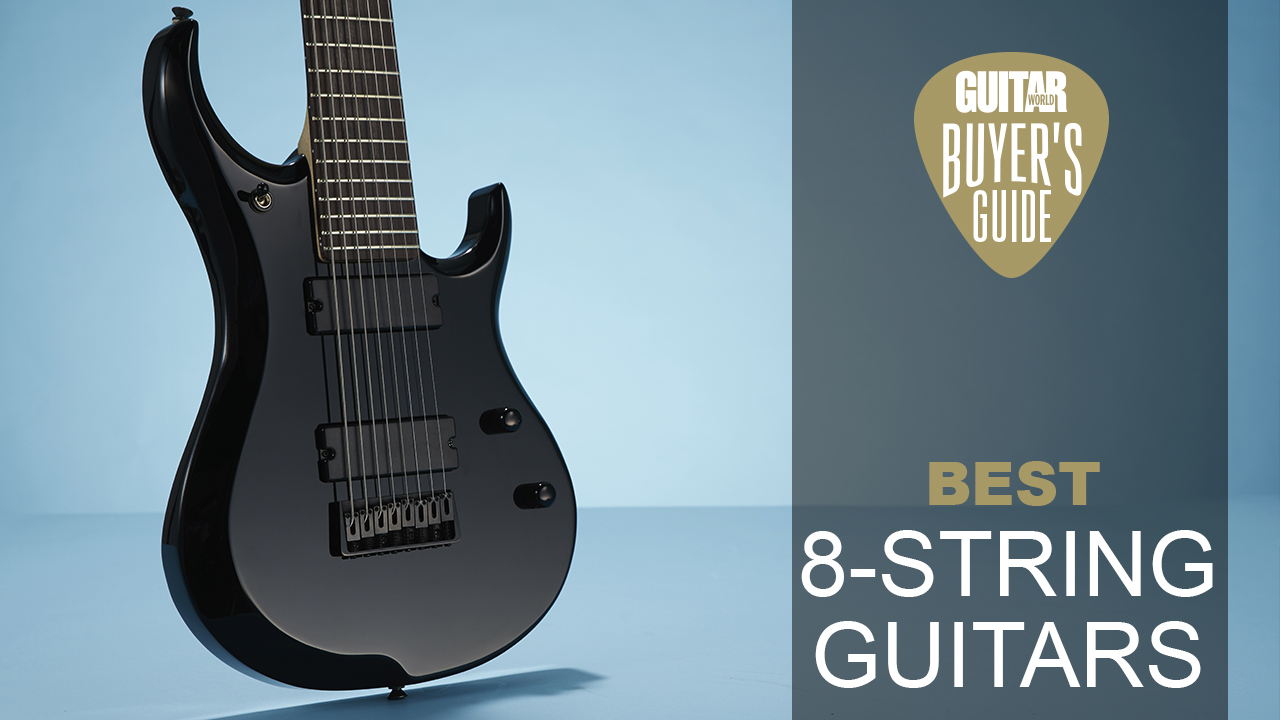
When the gut-thumping low end of a 7-string simply isn’t enough, you’ll instead want to turn your attention to the best 8-string guitars out there. One of these can unlock a whole new landscape for guitar playing, giving you access to frequencies previously impossible to reach.
An 8-string guitar is typically tuned F#, B, E, A, D, G, B, E, though if you figure that you might as well go the full octave lower, you can drop your bottom F# to an E. Here, you’re really in bass territory. So, if you’re playing in a situation without a bassist, then an 8-string can come in handy to ensure that the whole frequency range we’re used to hearing in modern music is there.
There’s no denying that you’ll often see 8-string guitars in the hands of metal players – after all, they’re perfect for super down-tuned riffs and chugging, but that’s not all they’re good for; we’re hearing more and more players get some seriously unique and non-traditional sounds from their guitars, and 8-strings can help you do just that.
Whether you’re into jazz, math rock, ambient or anything else that lies outside the realm of ‘ordinary’ music, one of the best 8-string guitars could be the thing that helps push your creativity. We’ve put together our list of what we reckon to be the best choices on the market for all budgets, and included some buying advice further down the page to help you get the most for your money.
Best 8-string guitars: Our top picks
The best 8-string guitar will of course depend on your needs as a player, but it’s hard to ignore the Jackson X Series Soloist Arch Top SLAT8 Multi-Scale. With its EMG 909 pickups, it’s capable of delivering crushing distorted sounds whilst retaining lots of clarity.
For players on a tighter budget, we’d recommend the Schecter Omen-8. The regular scale might appeal to those that are new to guitars with more strings, plus it’s built to a good standard and comes fitted with a decent pair of passive humbuckers that will take care of all sorts of metal and beyond.
Best 8-string guitars: Product guide
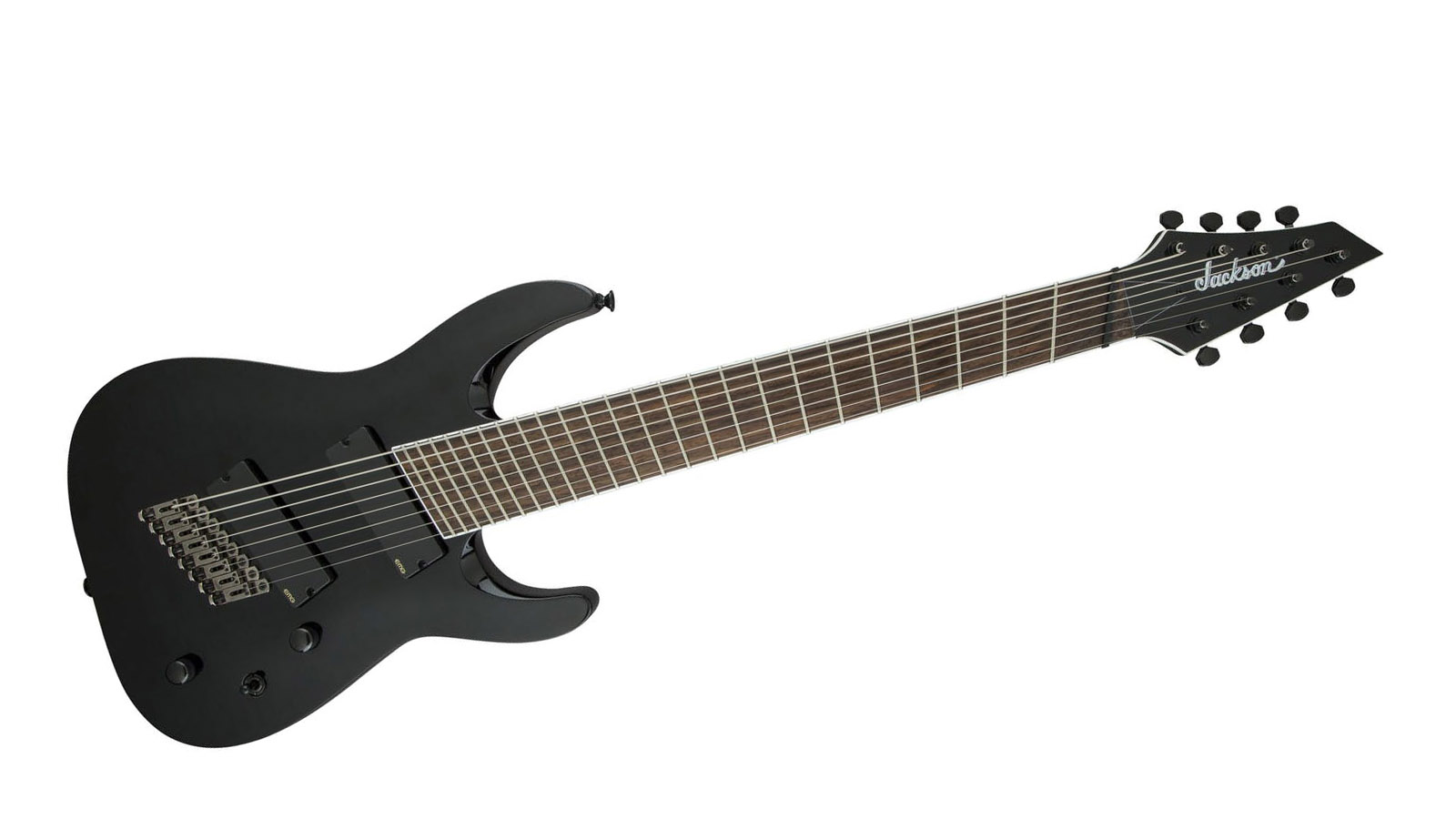
1. Jackson X Series Soloist Arch Top SLAT8 Multi-Scale
Our expert review:
Specifications
Reasons to buy
Reasons to avoid
Given that the Jackson Soloist is one of the archetypical hot-rodded S-styles, it shouldn’t come as a surprise that it should wear the extended range format so well. Here we’ve got the reassuringly familiar Soloist body shape, with none-more-solid neck-through construction as good a guarantee of sustain as you’ll get.
With a scarf joint and two graphite rods, that neck feels it’s not going anywhere. The nut width is a generous 53.85mm, so the laurel fretboard doesn’t feel crammed, and with a 12"-16" compound radius it is gently curved low down where you’re typically fretting chords and flattens out up top for lead playing. For 8-string neophytes, it is a most welcoming proposition, and the multi-scale fretboard might confuse the eye at first but it’ll make sense under your fingertips, with that low F.
Tone-wise the Soloist takes no prisoners, with a pair of active EMG 909 humbuckers in bridge and neck positions. There’s a searing bite to that bridge humbucker, while it mellows out some of that high-end sizzle in the neck. The middle position with both fully engaged adds awesome texture to your riffs.
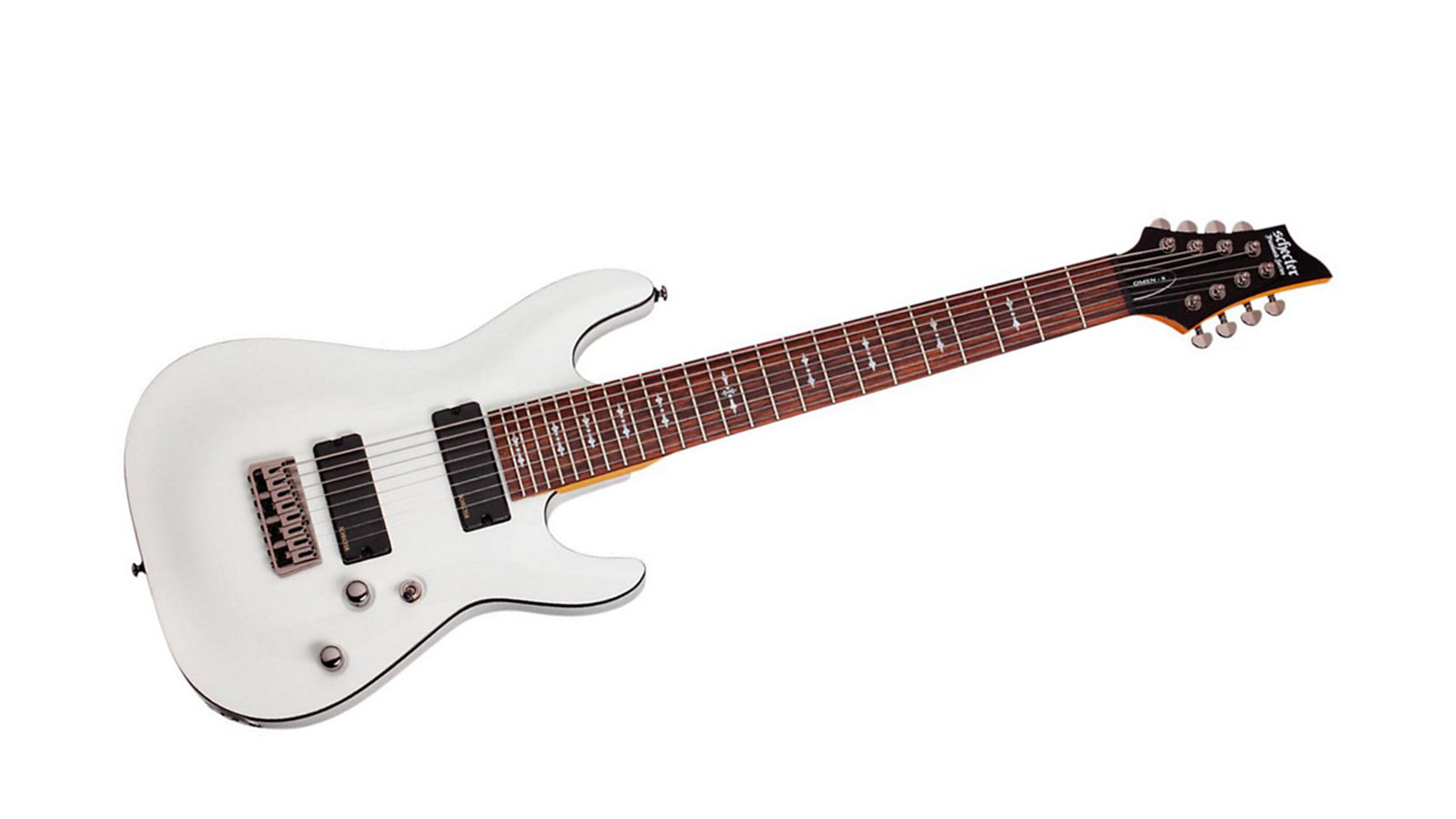
2. Schecter Omen-8
Our expert review:
Specifications
Reasons to buy
Reasons to avoid
The Omen-8 has been around for what seems like forever and yet it remains a favorite for its wallet-friendly price point, solid build and excellent feel. This would make an excellent debut 8-string. The factory setup ships the Omen-8 with a set of Ernie Ball strings running 010-.074, with that heavy low eighth string offering a nice balance between the approachable 26.5” scale length and the string tension needed to hold up under heavy riffing.
The balance and the weight feels bang-on. With its carbon fibre reinforcement, the maple neck feels good and solid, and allied to the fairly flat 16” rosewood fingerboard, complete with 24 extra-jumbo frets, it makes for one very shreddable 8-string. A pair of Schecter’s overwound passive humbuckers might not excite you in the way a pair of active Fishman Fluence pickups might but they do an excellent job of translating low-tunings and high-gain scenarios into something that’s simply musically devastating, which is good to know, as that is very much the design brief here.

3. Ibanez Prestige RG5328 – Lightning Through A Dark
Our expert review:
Specifications
Reasons to buy
Reasons to avoid
No list of the best 8-string guitars would be complete without an O.G. pick from Ibanez, and this Prestige model has the immaculate build and finish we would expect from its Japanese-built models, that’s exemplified by the Prestige fret-edge treatment that gives its ebony fretboard such a luxurious feel.
While the RG silhouette will always race a flutter in the heart of every shredder, Ibanez has gone for a sober finish on a guitar that is wholly geared towards playability and tone. The five-piece Wizard neck is a slimline sandwich of maple and wenge, super smooth, super quick, measuring 55mm wide at the nut but just 19mm deep at the first fret. That’s fast.
The hardware is quality throughout, with a set of locking Gotoh tuners up top and a Gibraltar Standard II-8 hardtail bridge a triumph in minimalism, and little touches such as the Luminlay side dot fret markers are just the icing on the cake. The DiMarzio Fusion Edge humbuckers are hot, dynamic, and the coil-tap switch profoundly expands the RG5328’s tone menu. This is one versatile 8-string that ships in a factory tuning of 1D#, 2A#, 3F#, 4C#, 5G#, 6D#, 7A#, 8F.

4. ESP LTD Javier Reyes JR-208
Our expert review:
Specifications
Reasons to buy
Reasons to avoid
Not all 8-strings need follow the Superstrat format. Take the ESP LTD Javier Reyes signature model. The Animals As Leaders riff-master has gone for an offset double-cutaway body that’s ergonomically rounded in all the right places, with a bolt-on maple neck with a low-profile heel joint, and chamfering in both cutaways to enhance upper-fret access.
The Pelham Blue finish calls to mind classic Gibson guitars of yore, and is contrasted nicely with the gold hardware, but this sense of classicism belies the fact that this is a guitar that is driving 8-string guitar design further.
The JR-208 has a full 27” baritone scale length, that keeps those bass strings good and tight so you can really dig in, but once you acclimatise to a neck length that’s more bowling lane than Les Paul, the chances are you’ll find the thin U-profile neck and judiciously flat 15.7” fretboard radius a very comfortable platform for musical adventure.
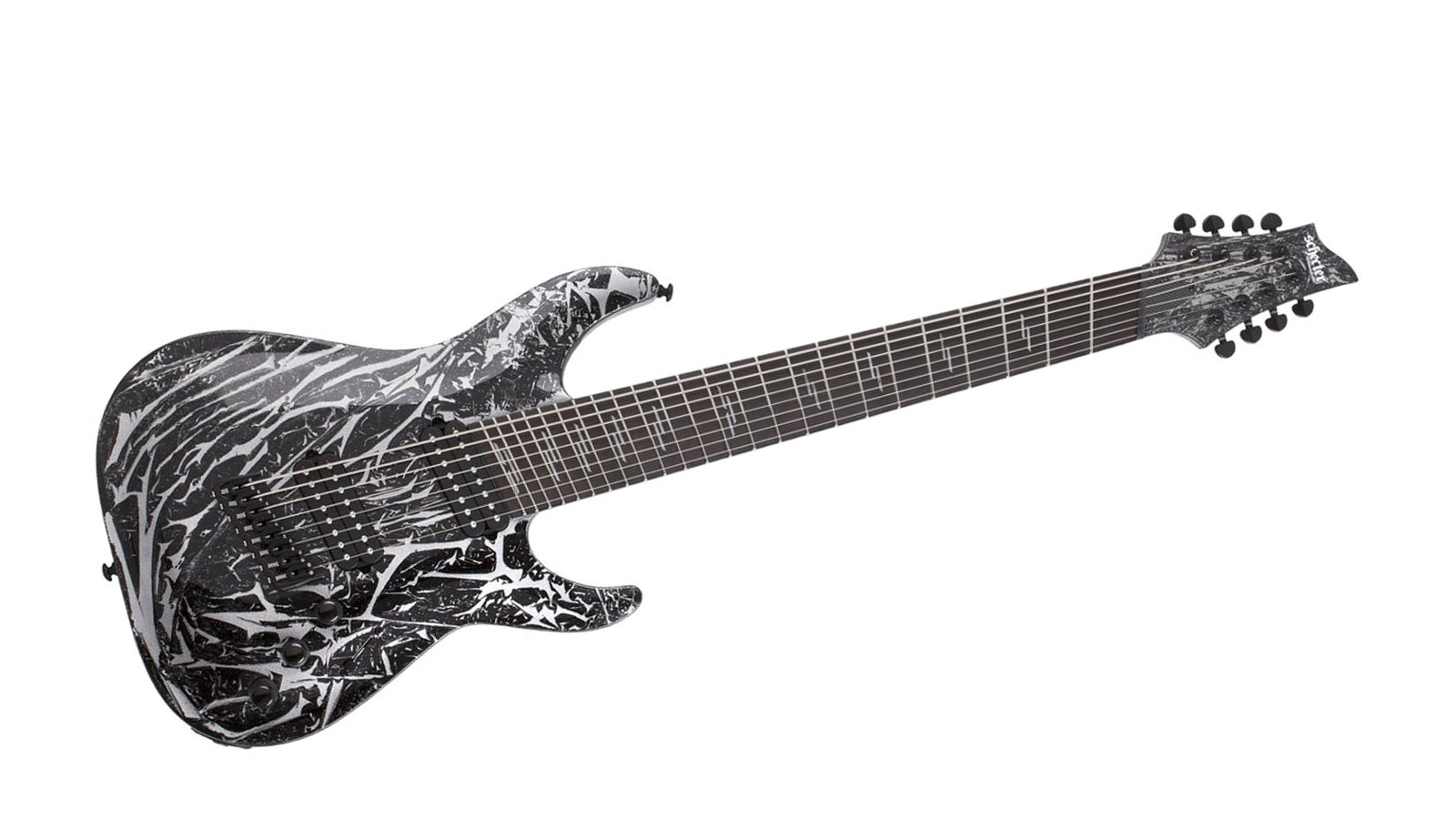
5. Schecter C-8 Multiscale Silver Mountain
Our expert review:
Specifications
Reasons to buy
Reasons to avoid
The Silver Mountain finish is going to divide opinion but there is no question that it nails the ’80s shred style, and it is beautifully applied to body and neck alike. Schecter has always been a redoubtable presence on the 8-string guitar market and the Silver Mountain applies all of the company’s experience in a guitar that is built for future-forward metal styles.
The mahogany neck is described as a deep insert neck, which is a set neck but feels very much like a neck-through build, with exceptional resonance and sustain and very generous access to the upper frets. There’s a set of locking tuners and an industry standard Hipshot bridge to keep things solid. This, allied to the 25.5” to 27” multi-scale design, gives the Silver Mountain a real state-of-the-art feel.
The tones are rich, thick and warm, the big old slab of mahogany rounding out the inherent brightness and gnarly output of Schecter’s in-house pickups. Incidentally, these are another very impressive pairing, even if the name Sonic Seducer is as goofy as it comes. As per the Ibanez RG5328, the volume, tone, 3-way selector and coil-tap setup gives the C-8 Silver Mountain a wide variety of tones to play with.

6. Jackson JS Series Dinky Arch Top JS32-8 DKA HT
Our expert review:
Specifications
Reasons to buy
Reasons to avoid
Like the Omen-8, the JS32-8 places what was in times of yore a boutique custom-built instrument within the reach of beginners, and does so while making the 8-string format playable and fun.
You won’t have the bells and whistles in Jackson’s JS series, but entry-level models such as this nonetheless stick to sound principles of guitar design. The neck has a player-friendly 12”-16” compound radius and an approachable 26.5” scale (just an inch longer than standard Fender scale), but crucially it is graphite-reinforced and typical of a build that does well to get the basics right.
The Jackson humbuckers are hot enough to tease out harmonic squeals and a rhythm guitar tone that could cause structural damage. The Dinky body remains one of the most ergonomically pleasing S-style shapes in guitar design. Great value, great fun, and a fine candidate for buying and modding.
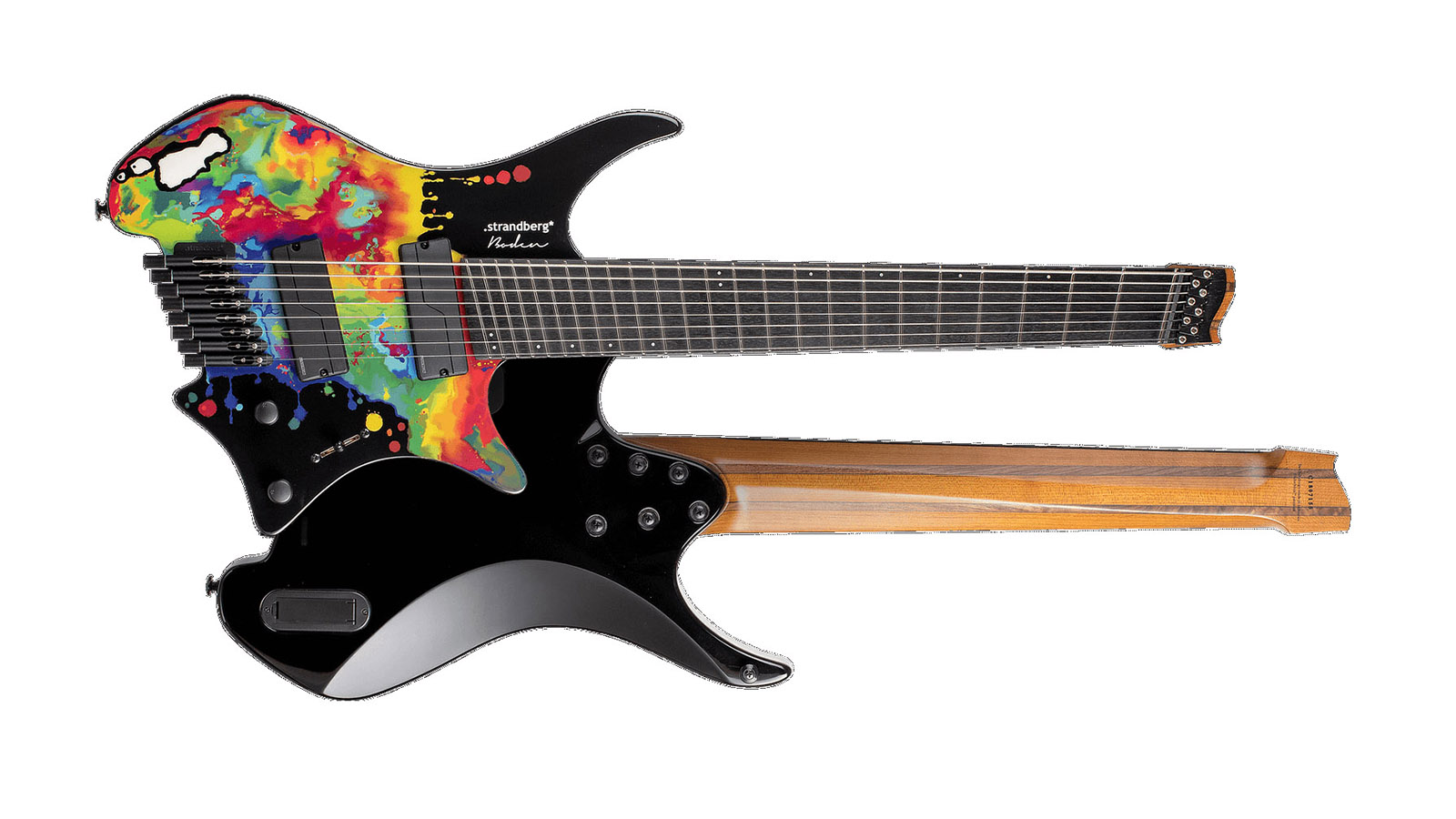
7. Strandberg Boden 8 Sarah Longfield Edition
Our expert review:
Specifications
Reasons to buy
Reasons to avoid
Strandberg’s designs for 8-string guitars are so forward thinking that to look at a gifted, groundbreaking player such as Sarah Longfield playing them is like being Neanderthal Man watching someone ordering groceries on their iPad. Of course, the headless design reprises the ‘80s Steinberger template but we are seeing it here in an all new light.
Everything seems new and exciting (body shape, bridge design, Fishman Fluence pickups). Everything is premium (Jescar stainless steel frets, roasted maple ‘board, Fishman Fluence pickups). And more to the point, everything about the Sarah Longfield Boden 8 is so playable, with the chambered basswood and maple-topped body offering a lightweight and manageable playing experience that is only enhanced by a very flat 20” fingerboard radius.
The Fluence Modern humbuckers, with their switchable voicings, are a perfect pairing for a guitar such as this. And sure, the Boden 8 Sarah Longfield Edition is not cheap, but for the dedicated 8-string player, and those who, like Longfield, need a pro-quality instrument to deliver on the extended-range format’s promise, it is very much worth the outlay.
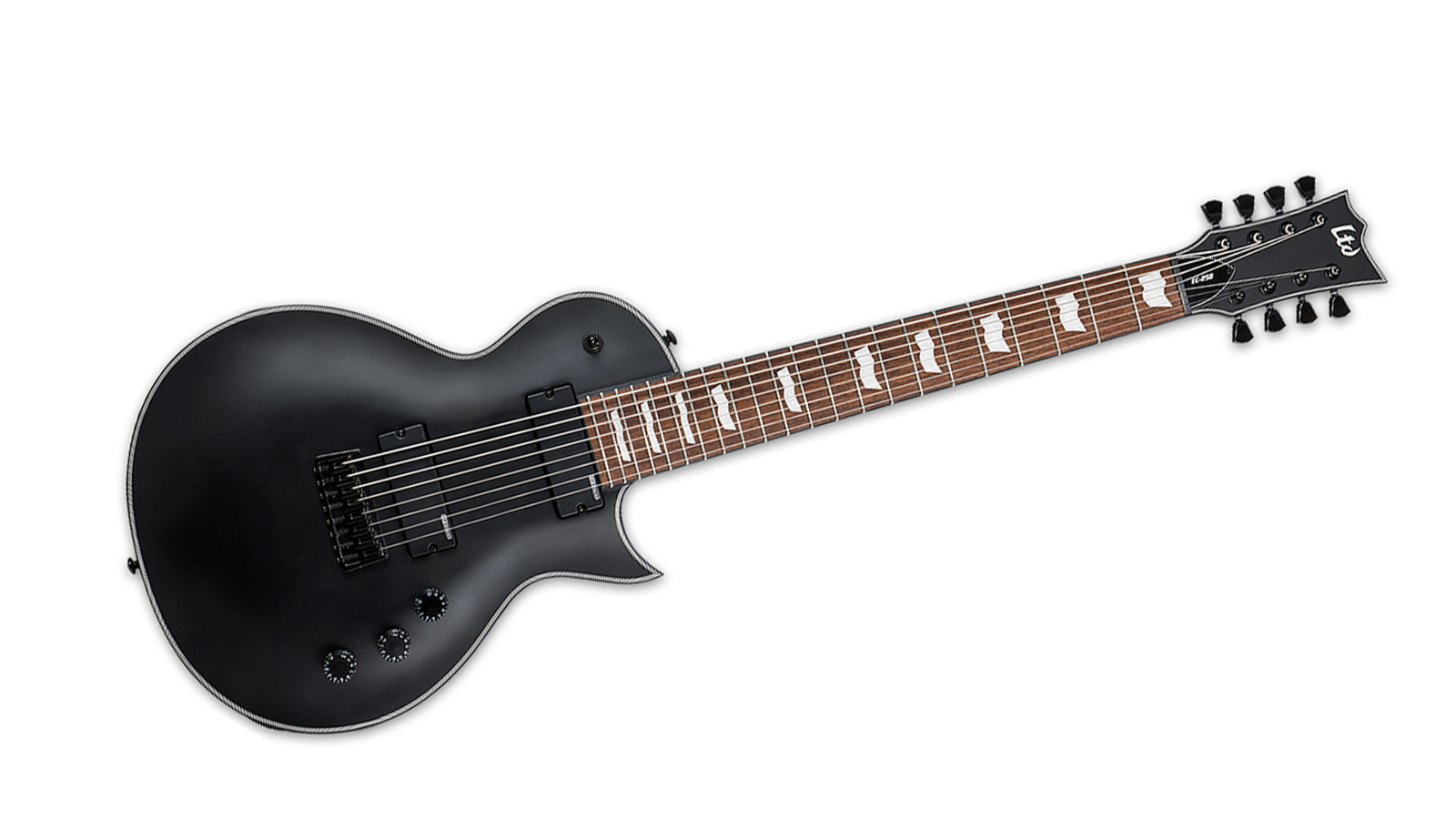
8. ESP LTD EC-258
Our expert review:
Specifications
Reasons to buy
Reasons to avoid
8-strings are great for contemporary metal and djent, amongst many other sub-genres of heavy music, but that doesn’t necessarily mean you want a flash, spiky guitar. Sometimes a classic body shape is the way to go and this single cut offering from LTD gives you just that, and at a cracking price, too.
Fitted with a pair of powerful passive humbuckers, this guitar is capable of all sorts of bone-crushing tones, whilst still being fairly versatile. The tone knob acts as a push/pull allowing you to get more single-coil like sounds from it. Switching from this sound to the full-fat humbucker is great for transitioning from softer, quieter sections of a song to louder, more aggressive parts.
The thin U neck profile is comfortable and easy to get your hand around, plus the 26.5” baritone scale helps keep the bottom end tight and tuning stable. If you’re looking for one of the best 8-string guitars on a budget, then give this model some serious thought.
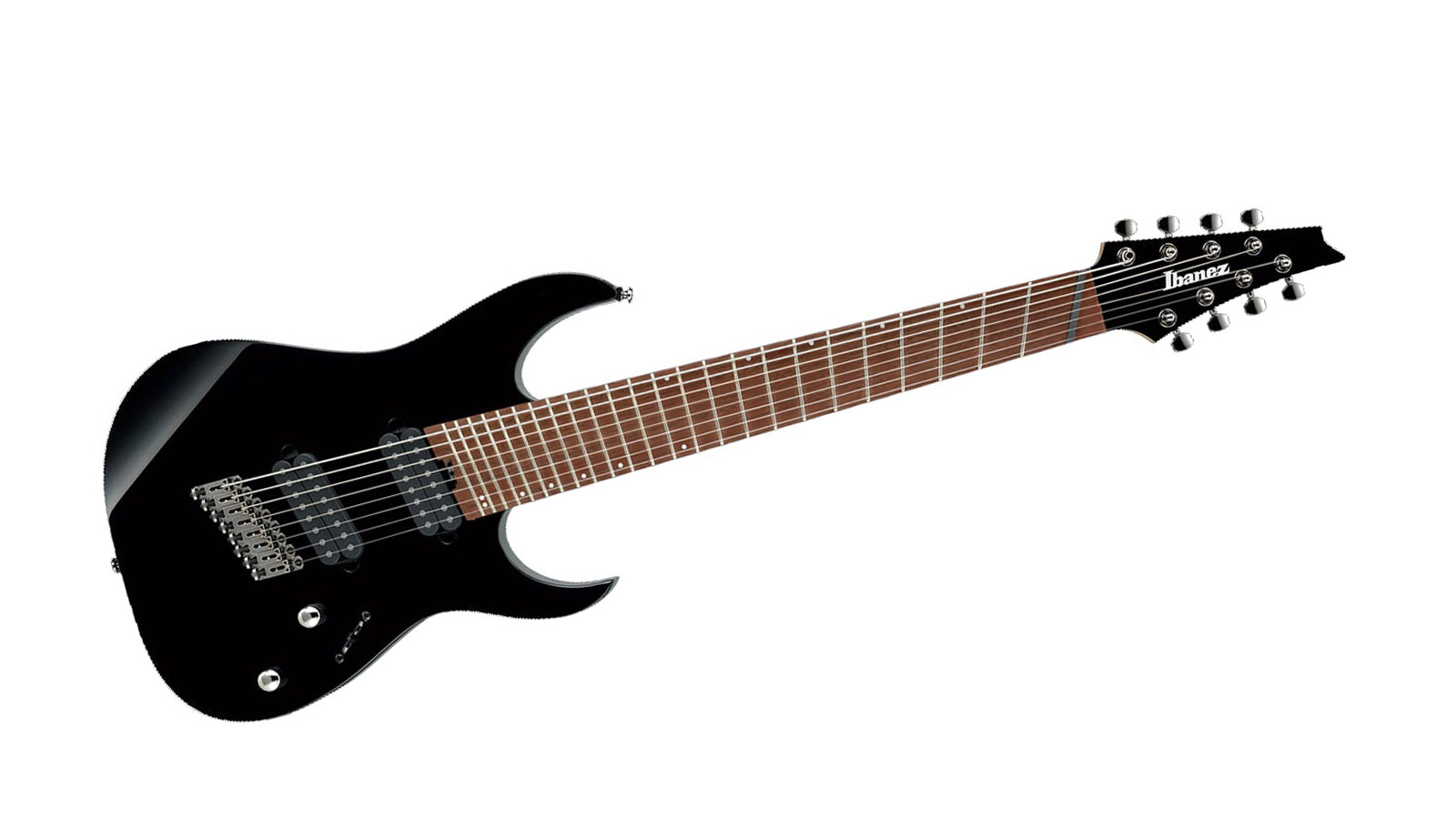
9. Ibanez RGMS8 Iron Label Multi-Scale
Our expert review:
Specifications
Reasons to buy
Reasons to avoid
Ibanez’s metal-focused Iron Label Series offers good value for weaponized guitar spec, and the RGMS8 is a seriously powered 8-string S-style. For just over 500 bucks you’ll get a multi-scale instrument, running from a conventional RG scale of 25.5” on the first string, down to a baritone 27.2” on the low eighth string.
The RGMS8 also borrows some construction inspiration from its more expensive siblings, with it, too, using a five-piece maple and walnut neck in an über-svelte Ibanez Wizard III-8 profile. Measuring 20mm deep at the first fret, with a very gentle taper to 21mm at the 12th, it’s similarly built for speedsters, but also makes the RGMS8 very accessible for players fretting chords on an 8-string for the first time.
The five-way switching system allows for full exploration of the impressive Array humbuckers. You can access the neck pickup in series or in parallel, both pickups in series, both pickups’ inner coils, and the bridge pickup in series. Those parallel and outer coil positions give the RGMS8 some very persuasive clean tones, particularly if you augment them with a little modulation. Like the Jackson JS Series Dinky, this would make a good candidate for modding further down the line.
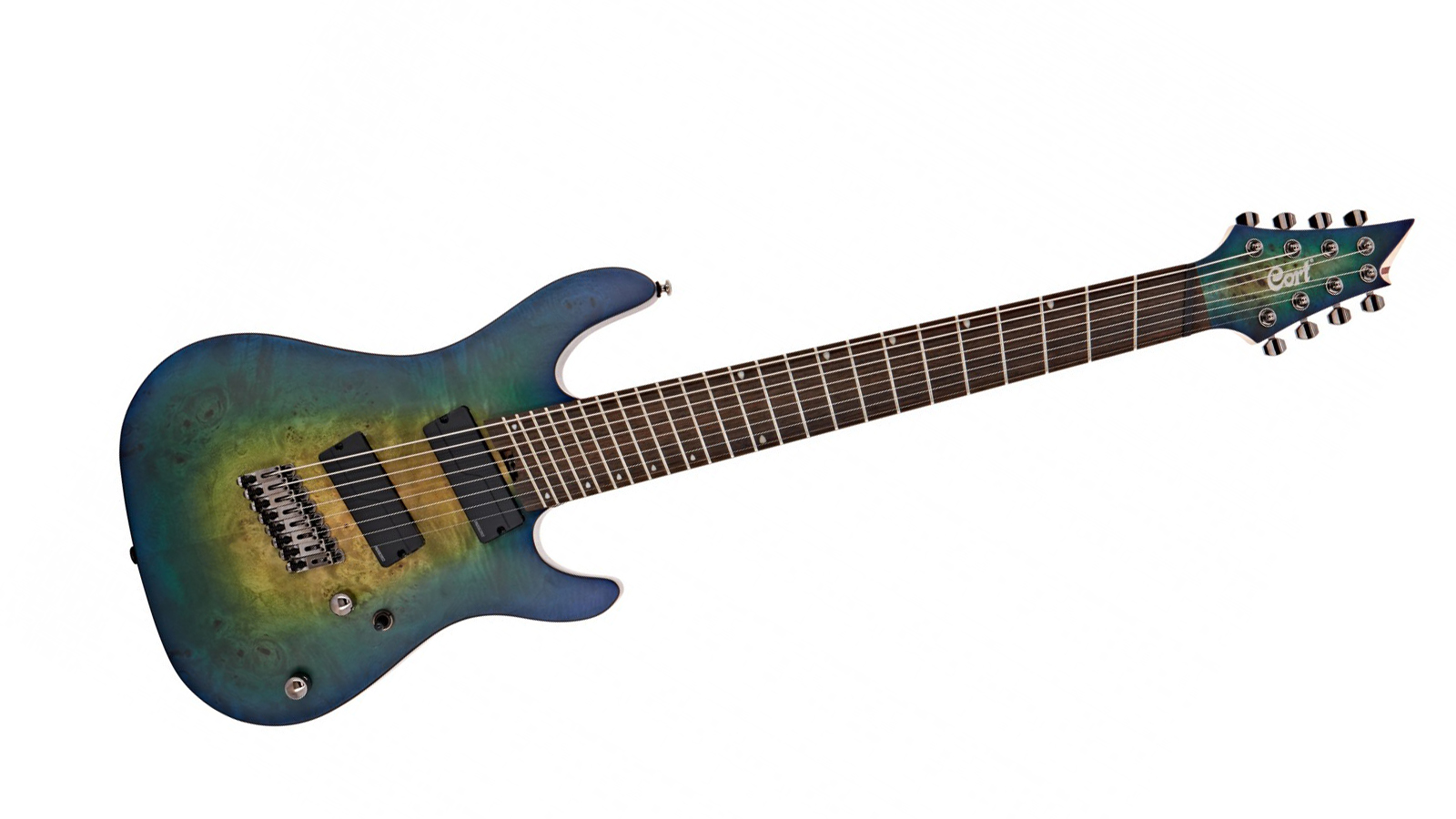
10. Cort KX508MSII
Our expert review:
Specifications
Reasons to buy
Reasons to avoid
In recent years, Cort guitars have been going from strength to strength. Previously, they were known more as a budget brand, but in the last few years have showcased some incredible guitar designs boasting some serious specs. The KX508 II is just that – a high quality 8-string guitar that looks great and also sports some of the best pickups out there.
Sitting atop the impressive spec list are the Fishman Fluence pickups. These are versatile humbuckers that have two voices, accessed via the push/pull volume knob and essentially give you the benefits of both passive and active pickups. So within one guitar you’ve got both hot, searing, modern tones, as well as more classic, organic humbucker tones. Then, the tone knob allows you to access single coils sounds too – versatile indeed!
Add to this some beautiful, exotic woods and high quality hardware, as well as a 26.5-28” multi-scale, and you’ve got one of the best 8-string guitars on the market, for less than a grand.
Best 8-string guitars: Buying advice
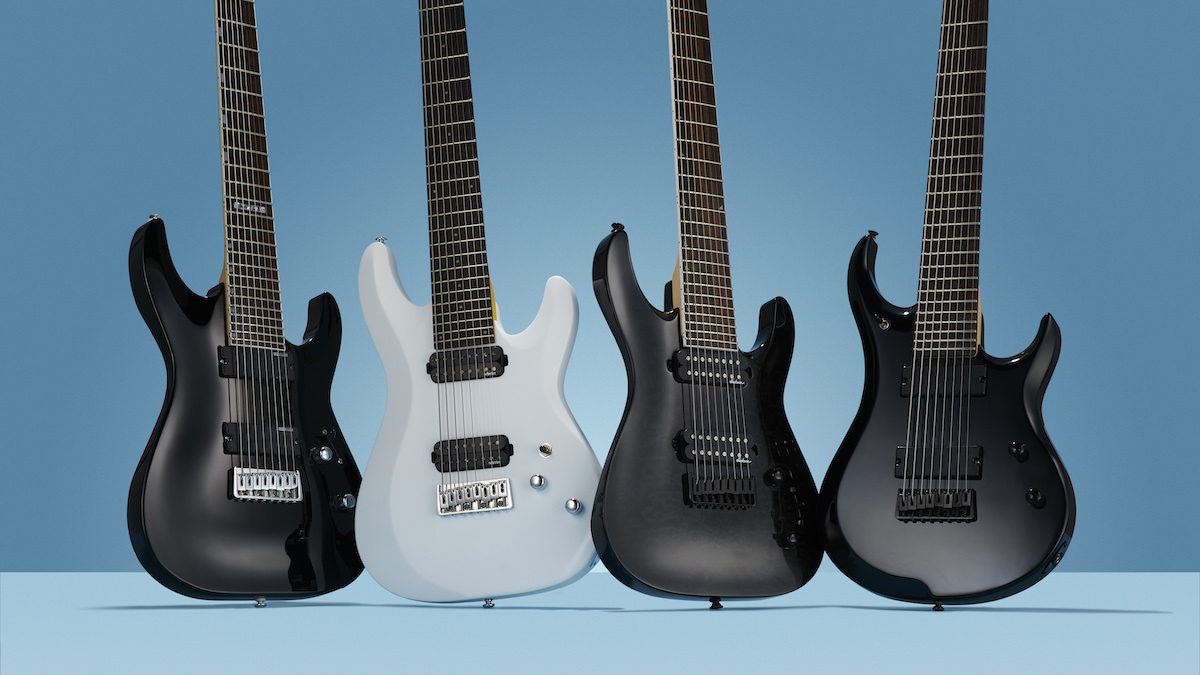
The 8-string guitar might still be a niche instrument, a specialist’s weapon, but its evolution has accelerated in recent years. The big bang came in the shape of the Ibanez RG2228, which took the much-loved RG S-style shred template and expanded it for 8-strings. It was the first mass-produced model, and it would find early adopters in players such as Animals As Leaders’ Tosin Abasi and Periphery’s Jake Bowen. But in today’s market you’ve got a fair degree of choice in body shapes, builds and pickups.
What should I consider when choosing my first 8-string guitar?
For players making their first steps into 8-strings, there are some points to note. The first is a question of fretboard geography – to accommodate the lower tunings and maintain string tension, the scale lengths are considerably longer than on regular six-string guitars, measuring from a relatively short 26.5” to 28” or more. This takes some getting used to.
With a nod to playability and intonation, many guitar builders now incorporate multi-scale designs on their 8-string guitars, which is to say their guitars have more than one scale, typically running a very standard 25.5” from nut to bridge on the high-E string to a generous 28” on the low eighth string.
Six-stringers will also find the nut width a change of pace. Where a conventional six-string might measure 43mm across the nut, to accommodate the extra two strings an 8-string typically measures around 54mm, which is quite the stretch. There is no “correct” nut width, just that which feels right to you, with string spacing making sure the fingerboard is not too crammed nor too spaced out.
Of all the demands made on the 8-string guitar’s anatomy, the neck gets the most abuse. You will find that most of these guitars have necks reinforced with either graphite or titanium rods. Some manufacturers opt for a sandwiched construction to aid stability. If your prospective 8-string lacks stability in the neck, you are invariably in for tuning problems further down the line.
It’s always worth fretting playing some open strings and gently applying some pressure to the headstock to see how far the guitar will go out of pitch; you should meet plenty of resistance from a solidly built instrument.
Multi-scale/fan fret vs traditional scale length
You can trust Guitar World
With an extra two low strings, the tension on an 8-string guitar is very different to that of a regular 6-string. This is why many of the best 8-string guitars feature fanned frets, or a multi-scale neck (both mean the same thing). To look at, everything looks a bit diagonal and the lower strings are a little longer than the higher strings.
If you were to look at the inside of an acoustic piano, you’d see that the lower strings are longer than the higher ones. This is because they sound better and clearer that way – the same sort of thing applies to an 8-string guitar, plus you’ll usually find that this helps keep it all in tune better. Fanned frets also help with intonation, so your guitar plays more in tune up and down the neck.
So, are multiscale 8-strings better than regular scale models? That’s up to you; while there are advantages, they do feel different and if you can’t get the hang of playing a multi-scale, then maybe just stick to what you know.

Neck feel
The feel of the guitar is a massive consideration to make when considering an 8-string. After all, if it’s not comfortable for you to play, then you’re not going to want to pick it up, and that’s no good at all.
Firstly, if you’re making the jump from 6 to 8-string, then you’re going to have to spend a bit of time getting used to the different string spacing and wider neck, so keep an eye on the neck profile whilst browsing. It also takes a while remembering you’re not on your lowest string when you’re on your bottom E string. But, the more you play it the quicker you’ll get used to it.
Do I need active or passive pickups in my 8-string guitar?
Like with 7-strings, when looking for the best 8-string guitar, you’ll find that the biggest decision you’ll have to make tone-wise is whether to go for passive or active pickups.
Because 8-strings are used widely within metal, you’ll find that a lot of them come equipped with active pickups. These feature a built-in preamp and often yield a very high output, making them break up or distort quicker. They sound great with heaps of gain, but remain nice and clear – ideal when you’ve got such a wide frequency range. The active pickups can really help keep everything sounding fat and tight in the low end.
Passive pickups are more traditional, and are usually more dynamic allowing for more expression in your playing. If high gain tones are your thing, it doesn’t necessarily mean you should discount passive pickups though. Many of the sets fitted in our pick of the best 8-string guitars have high-outputs and have actually been made specifically with chunky high gain sounds in mind.
Find out more about how we make our recommendations and how we test each of the products in our buyer's guides.
Related buyer's guides
- 8-string too much? These are the best 7-string guitars
- The best metal guitars for shredders
- Boost your tone with the best pickups for metal
- Loud and proud: these are the best amps for metal
- Best basses for metal: plus everything you need to find the bass for you
- Learn to play on the best beginner electric guitars
- Best distortion pedals for metal: standalone and stacked gain stages
All the latest guitar news, interviews, lessons, reviews, deals and more, direct to your inbox!
Jonathan Horsley has been writing about guitars since 2005, playing them since 1990, and regularly contributes to publications including Guitar World, MusicRadar and Total Guitar. He uses Jazz III nylon picks, 10s during the week, 9s at the weekend, and shamefully still struggles with rhythm figure one of Van Halen’s Panama.

